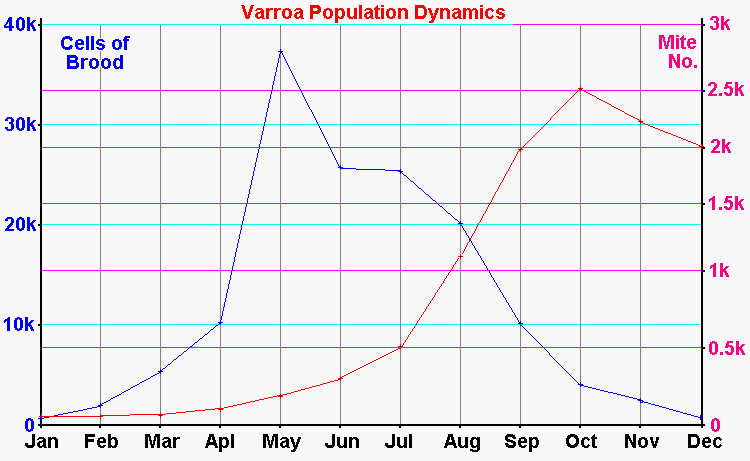| |
Varroa jacobsoni/Varroa destructor
A Parasite Of Honey Bees
This page has been archived. It is retained for historical purposes and should not be relied upon for information
This little eight legged "beastie" is a monster in the eyes of
beekeepers throughout the world. It is a parasite that is out of balance with it's host and
multiplies to the extent that it kills the host bee colony and thus dies itself.
|
|---|
|
These pictures of varroa have come from other websites.
The Scanning Electron Micrograph is due to Garry Fry in the CSL photography department.
| |

| |

|
|---|
As it is a "new" pest to many areas of the world there are many
researchers and research programs into all aspects of the problem.
In the short term we have to support our bees with
chemical treatments, but our aim is to breed bees
to enhance those elements in their nature that will ultimately lead to a balanced existence.
Thus the bees will survive with a minor endemic infestation of mites.

The graph above is only a representation (a compilation of old German
data) and should not be considered accurate enough to judge treatment timing.
This page is intended to describe varroa... The methods and substances used for
Varroa Treatment
are dealt with separately. The methods and substances used for
Varroa Detection also have a separate page.
Varroasis is often referred to as a disease... It is not, it is an infestation of
parasitic mites. It was discovered by Edward Jacobson and classified in 1904, by the Dutch
scientist Oudemans. Little study was performed until about 1960.
Recent work (by Doctor Denis Anderson) refers to size variations between mites found on
Apis cerana and those infesting Apis mellifera. Varroa jacobsoni is found in Java and was
discovered incapable of reproduction on Apis mellifera brood. Varroa found in Sri Lanka,
China,Japan, Thailand, Korea, Nepal and Vietnam was renamed, as a separate
species, known henceforth as Varroa destructor.
Other varroa mites found in the Philippines are possible candidates for yet other
separate species.
Colour of the female mite varies from a light chestnut
brown to a very dark brown. The male is off white to pale yellow, but is rarely seen as it
dies within the cell after mating.
Physical Size (female) 1.104 mm long (spread 1.045 - 1.098)
by 1.576 mm wide (spread 1.515 - 1.580). The body
of the male is almost circular and is 0.750? - 0.832? mm long.
(Another figure of 0.866? ± 0.0209 mm is also
quoted)... (Salchenko 1972). (since the discovery of Varroa destructor
the above dimensional data is questionable and will be refined later)
Varroa jacobsoni is circular whilst Varroa destructor is oval.
Spreading mechanisms. Varroa is spread within apiaries by
the beekeeper, transferring frames of brood from one colony to another.
By the bees, either within an apiary or apiary to apiary, by robbing,
wandering drones or drifting. Transfer from one apiary to another can
occur by migratory beekeeping or by introducing stock or queens from
infested sources. In the initial stages of any outbreak... Feral
stocks and untreated stocks provide a reservoir of infested bees.
1992 was the discovery date for varroa in the UK, but the
threat had been considered imminent since the 1979 Apimondia
conference. Varroa was first discovered in USA on September 25th
1987, in Saukville, Wisconsin.
History of Spread of Varroa... The model that is accepted
widely... Is that varroa developed in isolation with it's Apis cerana
host and that the spread since 1904 is simply due to managed migratory
beekeeping. I have a personal
alternative view
of a possible alternative to this process, that has so far received no support. This
alternative view has been derided by most, and some have been openly hostile to it.
D.A.C.
Page created pre-2001
Page archived 05/11/2020
Written... Date unknown,
Revised... 22 November 2001,
Upgraded... 11 December 2005,
Modified... 04 August 2006,
|


